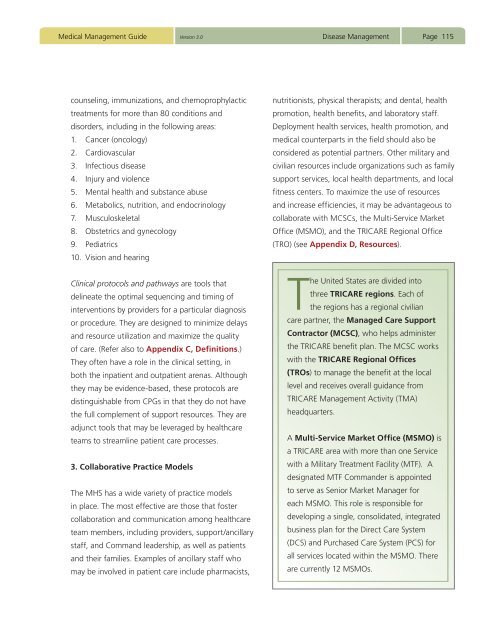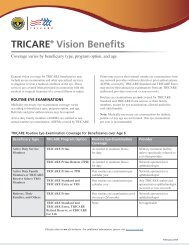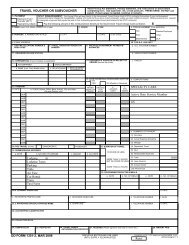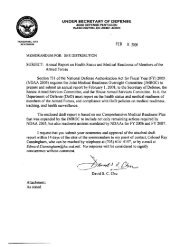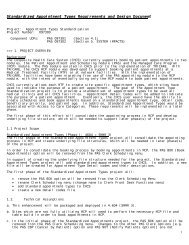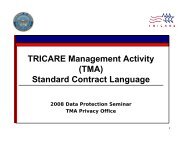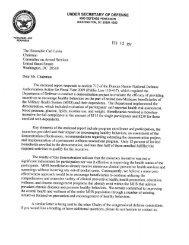Medical Management Guide, 2009, Version 3.0 - Tricare
Medical Management Guide, 2009, Version 3.0 - Tricare
Medical Management Guide, 2009, Version 3.0 - Tricare
- No tags were found...
Create successful ePaper yourself
Turn your PDF publications into a flip-book with our unique Google optimized e-Paper software.
<strong>Medical</strong> <strong>Management</strong> <strong>Guide</strong><strong>Version</strong> <strong>3.0</strong>Disease <strong>Management</strong>Page 115counseling, immunizations, and chemoprophylactictreatments for more than 80 conditions anddisorders, including in the following areas:1. Cancer (oncology)2. Cardiovascular3. Infectious disease4. Injury and violence5. Mental health and substance abuse6. Metabolics, nutrition, and endocrinology7. Musculoskeletal8. Obstetrics and gynecology9. Pediatrics10. Vision and hearingClinical protocols and pathways are tools thatdelineate the optimal sequencing and timing ofinterventions by providers for a particular diagnosisor procedure. They are designed to minimize delaysand resource utilization and maximize the qualityof care. (Refer also to Appendix C, Definitions.)They often have a role in the clinical setting, inboth the inpatient and outpatient arenas. Althoughthey may be evidence-based, these protocols aredistinguishable from CPGs in that they do not havethe full complement of support resources. They areadjunct tools that may be leveraged by healthcareteams to streamline patient care processes.3. Collaborative Practice ModelsThe MHS has a wide variety of practice modelsin place. The most effective are those that fostercollaboration and communication among healthcareteam members, including providers, support/ancillarystaff, and Command leadership, as well as patientsand their families. Examples of ancillary staff whomay be involved in patient care include pharmacists,nutritionists, physical therapists; and dental, healthpromotion, health benefits, and laboratory staff.Deployment health services, health promotion, andmedical counterparts in the field should also beconsidered as potential partners. Other military andcivilian resources include organizations such as familysupport services, local health departments, and localfitness centers. To maximize the use of resourcesand increase efficiencies, it may be advantageous tocollaborate with MCSCs, the Multi-Service MarketOffice (MSMO), and the TRICARE Regional Office(TRO) (see Appendix D, Resources).The United States are divided intothree TRICARE regions. Each ofthe regions has a regional civiliancare partner, the Managed Care SupportContractor (MCSC), who helps administerthe TRICARE benefit plan. The MCSC workswith the TRICARE Regional Offices(TROs) to manage the benefit at the locallevel and receives overall guidance fromTRICARE <strong>Management</strong> Activity (TMA)headquarters.A Multi-Service Market Office (MSMO) isa TRICARE area with more than one Servicewith a Military Treatment Facility (MTF). Adesignated MTF Commander is appointedto serve as Senior Market Manager foreach MSMO. This role is responsible fordeveloping a single, consolidated, integratedbusiness plan for the Direct Care System(DCS) and Purchased Care System (PCS) forall services located within the MSMO. Thereare currently 12 MSMOs.


